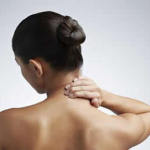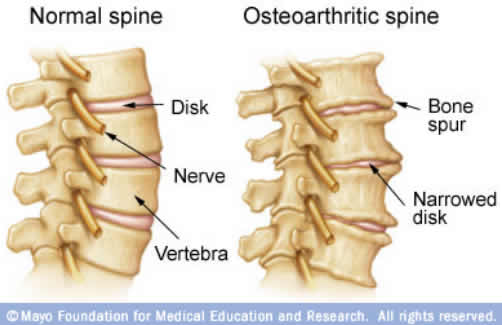Symptoms of Osteoarthritis in the Neck
Spinal stenosis is a condition of when the spine is narrowed. There are several causes and one of them is osteoarthritis (OA). Spine is a series of vertebrae extending from your lower back, neck, and to the skull. OA of spine can affect the neck, which joint pain in the affected area can be one of the most common symptoms.
When OA affects the spine, the discs in the neck and lower back are usually the common sites where it occurs. The reason is due to these sites are vulnerable to load stress /strain in your daily activities.
 As well we know that OA is a generative joint disease associated with the age. The older you are the greater chance you have to develop it.
As well we know that OA is a generative joint disease associated with the age. The older you are the greater chance you have to develop it.
However, the age is not the single risk factor. Experts believe that other factors may have a role. In fact, not all elderly people have it!
Joints of knees and hips are other common sites affected by OA. Even knee joints are the most commonly affected since they are the most essential weight-bearing (they often load the greatest strain in your daily routines).
As the age, the cartilage (a flexible tissue that cushions each disc /joint of spine so thus the joint can move smoothly with less strain & almost no friction) tends to wear away. So, OA of spine usually develops gradually over time and again much common in older adults (over the age of 40).
However, it also can occur at young ages. This is usually caused by the following causes:
- Having a genetic defective cartilage at birth.
- A trauma /injury that affects the spine.
In general, the problem is more likely to affect people with obesity and who have professions that put repetitive pressure on the joints of the spine. The following image is spine with vs. without osteoarthritis (credit to Mayo):
The most common symptom associated with OA of the spine is back pain. But if it affects the discs / joints in the neck, it can cause pain or stiffness in the neck.
Depending on the severity, the disease may cause numbness /weakness in your arms or even legs. Other secondary symptoms such as fatigue and cramping may also occur.
Typically, the joint pain of the affected area is felt deep in your muscles. Any activity that puts more strain to the affected joint (such as being upright) may worsen the symptoms. On the other hand, the discomforts are usually relieved by lying down.
The affected neck can be limited in motion. You may not be able /difficult to see the right or left side without rotating your body. Your neck can be stiff in the morning but this usually will last not more than one hour. This stiffness may also strike after periods of activity.
The physical effects can vary. While some can cope with the problem and don’t find serious problem in their daily activities, others can find serious difficulties in their daily routines since the disease gets worse.
The pain can progress unpredictably. But there are plenty of options for coping. The treatment approaches are dependent on the symptoms that occur and the severity of the problem.
The good news, most cases of osteoarthritis in the neck and spine doesn’t require surgical options.
Some lifestyle approaches (like weight control and some diet changes), pain relievers, anti-inflammatory medicines, and some physical therapies are usually the first choices of the treatment. If the problem does require surgery, some disc-replacement surgeries are available.
If you feel something wrong with your neck or spine, see a doctor! There are some tests that can help rule out the possible causes and make a diagnosis of osteoarthritis.
First, your doctor will ask the symptoms that you feel. He may also need to do a closely physical examination – though this procedure is typically not very specific in diagnosing OA of spine.
Imaging test particularly with x-ray test is the common choice. X-ray test will not show the damaged cartilage, but it can show the narrowed discs in the spine /neck. However sometime doctor may need to use other imaging tests such as MRIs or CT-scan. See more tests and procedure to diagnose osteoarthritis in this section!
As mentioned before, OA of spine is not the single answer for the cause of spinal stenosis. Other health conditions can generate the similar symptoms, some of them may include:
- The deposits of Ca (calcium) on the ligaments that line along the spine.
- Too high fluoride level in the body.
- Injuries due to the repetitively use of the joint.
- A benign growth (tumor) that affects the spine.
- Paget’s disease, a condition that can disrupt the normal life cycle of cells in the bone, causing disruption in the way of bone in repairing itself.
- http://www.niams.nih.gov/Health_Info/Spinal_Stenosis/spinal_stenosis_ff.asp
- http://spinecenter.ucla.edu/body.cfm?id=125
Last accessed on October 2014




